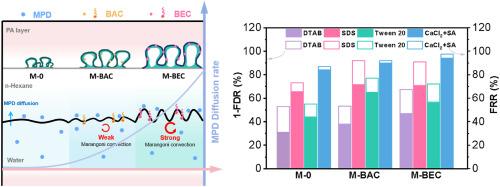Insights into the role of aromatic cationic surfactants in tailoring interfacial polymerization for high-performance reverse osmosis membranes
IF 9.5
引用次数: 0
Abstract
Surfactant-mediated interfacial polymerization (IP) has been recognized as a promising strategy for accurately modulation of the structure and performance of polyamide (PA) reverse osmosis (RO) membranes. While aromatic cationic surfactants have demonstrated potential in regulating IP processes, the influence of their molecular structure on IP process and their incorporation integrated into the PA layer remain unexplored. This work systematically investigates two model surfactants—benzalkonium chloride (BAC, single benzene) versus benzethonium chloride (BEC, dual benzene)—as molecular regulators during PA layer formation. The results reveal that both aromatic cationic surfactants facilitate the diffusion of m-phenylenediamine (MPD) from the aqueous to the organic phase, enhancing PA cross-linking, while simultaneously embedding into the PA matrix to modulate surface properties. Notably, BEC, due to its distinctive dual-benzene-ring structure, exhibits a superior ability to accelerate MPD diffusion, triggering more pronounced Marangoni convection during IP, which contributes to a higher leaf-like structure area (0.017 μm2) of the resulting PA layer. Additionally, the strong π–π interaction between BEC and the PA network leads to a high embedding ratio of BEC within the membrane. Consequently, the BEC-regulated RO membranes demonstrate enhanced perm-selectivity, alongside improved antifouling and antibacterial properties. This study presents novel perspectives on the strategic design of cost-effective and high-performance fabrication methods for RO membranes, demonstrating substantial promise for industrial applications.

芳香族阳离子表面活性剂在高性能反渗透膜界面聚合中的作用
表面活性剂介导的界面聚合(IP)被认为是精确调节聚酰胺(PA)反渗透(RO)膜结构和性能的一种有前途的策略。虽然芳香族阳离子表面活性剂在调控IP过程中表现出潜力,但其分子结构对IP过程的影响及其与PA层的结合仍未被探索。本研究系统地研究了两种模型表面活性剂——苯扎氯铵(BAC,单苯)和苯扎氯铵(BEC,双苯)——在PA层形成过程中作为分子调节剂的作用。结果表明,这两种芳香族阳离子表面活性剂均能促进间苯二胺(MPD)从水相向有机相的扩散,增强PA交联,同时嵌入PA基质中调节其表面性质。值得注意的是,BEC由于其独特的双苯环结构,表现出更强的加速MPD扩散的能力,在IP过程中触发更明显的Marangoni对流,这使得得到的PA层具有更高的叶状结构面积(0.017 μm2)。此外,BEC与PA网络之间强烈的π -π相互作用导致BEC在膜内的高嵌入率。因此,becc调控的反渗透膜表现出增强的热选择性,以及改善的防污和抗菌性能。这项研究为反渗透膜的成本效益和高性能制造方法的战略设计提供了新的视角,展示了工业应用的巨大前景。
本文章由计算机程序翻译,如有差异,请以英文原文为准。
求助全文
约1分钟内获得全文
求助全文

 求助内容:
求助内容: 应助结果提醒方式:
应助结果提醒方式:


